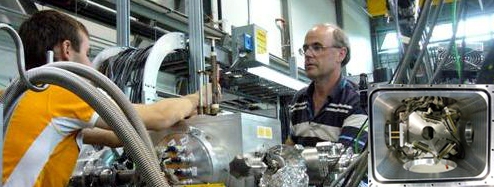
An international group of scientists led by researchers from the Spanish Research Council (CSIC), the University of Sevilla, and the University of Huelva recently completed a scattering experiment on thin lead targets. The experiment was performed at TRIUMF’s rare isotope facility, ISAC, using the world’s most intense beam of 11Li ions below 55 MeV. Beam rates of up to 7000 11Li per second were produced and focused onto a beam spot size of 2 mm diameter. The analysis of the experimental data will explore the structure of 11Li, which is an unusual isotope for having a cloud of neutrons surrounding a normal compact nuclear core. Such nuclei are known as “halo” nuclei, and they have sparked the interest of nuclear physicists around the world.
Because of the halo, the 11Li nucleus is about the same size as the lead nucleus even though 11Li has only 11 nucleons and lead has 208. The size increase of 11Li is due to two halo neutrons forming a cloud around a normal compact 9Li nucleus. The structure of this halo plays a key role in understanding the nuclear force and hence is the reason for the interest of the nuclear physics community.
The idea behind the experiment is to use a phenomenon that is thoroughly understood by modern physics—Rutherford scattering—and examine how 11Li scattering on lead departs from the predictions. Rutherford scattering is the result of normal like electric charges repelling each other. In this case, the positive 11Li nucleus repels the positive lead nucleus. The lead target was chosen as it is readily available and has a high Z number (Z is the number of positive charged protons in the nucleus; lead has 82). The large Z guarantees that 11Li-lead scattering would be dominated by Rutherford scattering if 11Li was a normal compact nucleus. The fact that it is a halo nucleus results in departures from Rutherford theory that can be analyzed for information about the nuclear halo. One informative phenomenon that has been observed is that the electric, or Coulomb, force interacts with the 9Li core to free the core from its neutron halo. This happens in hard, head-on collisions with the lead nucleus and results in the detection of 9Li nuclei. Many such events were identified and recorded during the experiment.
The experimental apparatus was small and compact. The entire experiment was contained in an approximately cubical scattering chamber of 35 cm per side. Eight square silicon strip detectors of thicknesses from 20 to 500 μm were arranged in four dE-E telescopes to detect the scattered 11Li and 9Li nuclei. The angular range covered was from 10 to 140 degrees. The lead target used had a thickness of 1.45 mg/cm2 (1.3 μm). The beam was threaded through collimators of 4 and 5 mm diameter, which protected the silicon detectors. The beam on target was approximately 2 mm in diameter and was counted by a downstream monolithic silicon detector. The entire apparatus with its associated electronics and data acquisition system was shipped to TRIUMF from overseas.
The data collected during the experiment are now going through a thorough offline analysis. The results will be published in peer-reviewed scientific journals. More information regarding the experiment can be found on the wiki site: http://www.triumf.info/wiki/tuda-tactic/index.php/E1104.
Banner photo : Busy setting up the E1104 experiment, July 2008. The inset shows the inside of the chamber with the 4 detector telescopes, in total 1024 tiny detectors (pixels) of 3x3 mm.
Inset photo : Young researchers from the Spanish groups resting at the Fraser dormitory after the shift: M. Cubero, D. Galaviz, M. Alcorta, L. Acosta, and A. Sanchez
Article by: Pat Walden
Kaitlan Huckabone
TRIUMF's Communications Assistant

